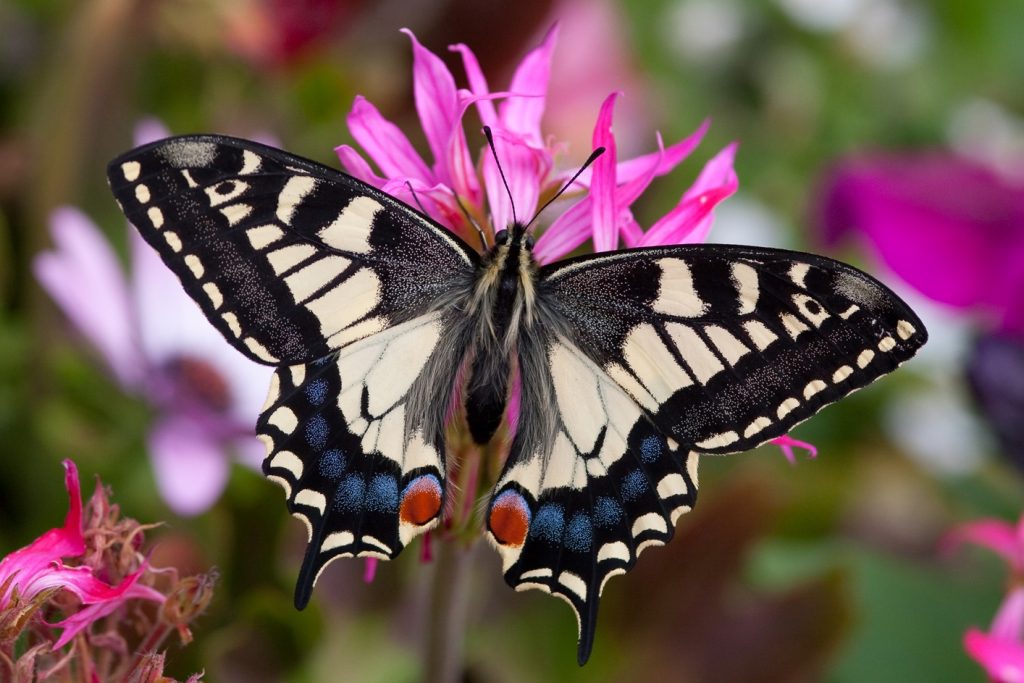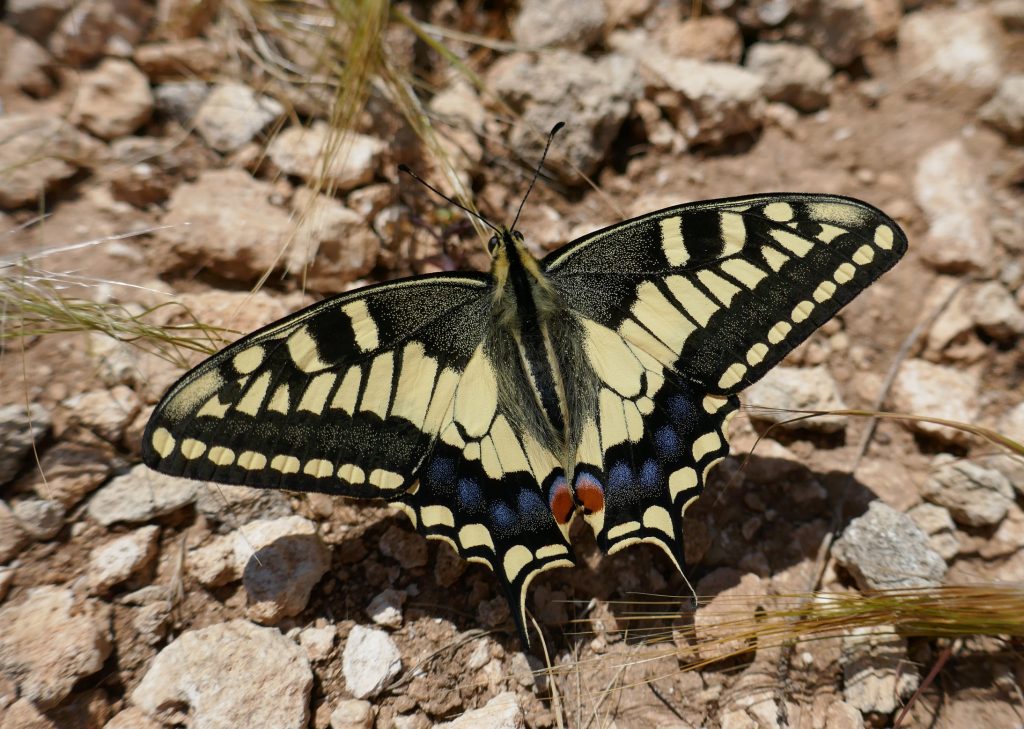
When I was eight, my father bought me a book, A colour guide to familiar Butterflies, Caterpillars and Chrysalides by Josef Moucha, beautifully illustrated by Bohumil Vančura. There was not much money in our home, so I was surprised as well as delighted with the book. Many happy hours were passed drawing and painting butterflies from the book. The first butterfly illustrated is the Swallowtail Papilio machaon. The illustrations show the butterfly with wings extended, the pupa affixed to a dead stem and the feeding caterpillar, perched high on a foodplant. The plant is an unnamed umbellifer (celery, carrot and parsley family).
The Swallowtail is a large, beautiful species, well distributed in Europe. It also occurs in North Africa, temperate areas of Asia and parts of North America. It also occurs on Mediterranean islands, including small islands like Gozo (Malta). Last year, the Swallowtail on Lampedusa Island in the Mediterranean was identified as a new subspecies, not of the Common Swallowtail Papilio machaon but of the Desert Swallowtail Papilio saharae. The adult Desert Swallowtail looks identical to the Common Swallowtail when seen in the field. The study that makes this claim examines all life stages and is a morphometric study (looking at the size, shape, colour etc of individuals). It did not use genetic techniques.
I have read the study carefully, and while the butterflies on Lampedusa have characteristics referable to the Desert Swallowtail, they also share traits with the Common Swallowtail. For example, the adult Desert Swallowtail has 30-31 antennal segments, while the adult Common Swallowtail has 33-36 antennal segments. Most of the Lampedusa specimens had 30-31 segments but some had 33 and one had 35.
The authors note “that the population on the island of Lampedusa possesses morphological traits of both P. saharae and P. machaon, plausibly the result of a hybrid swarm…” Intriguingly, the authors state: “The Lampedusa taxon appears to be, quite literally, a species in the making through the process of natural hybridization. Papilio saharae and P. machaon are known to hybridise naturally in Israel, where the two species maintain a contemporary sympatric association (both species occur together in the same area), contrary to the case of the Lampedusa taxon (a taxon is a biological entity of any status), which has been isolated for millennia.”
The authors made the decision, based on their morphometric analysis of all our four life stages, to recognise the swallowtail found in Lampedusa as a ‘new’ subspecies of the Desert Swallowtail, proposing the name Papilio saharae aferpilaggi ssp. nov (ssp. nov. means new subspecies; the subspecies name refers to the fact that the taxon originated in Africa, hence, the use of the adjective âfer which implies “of Africa”, while pilaggi is derived from the Sicilian name of the island group, Ìsuli Pilaggî.’)
One of the features that I did find persuasive for anchoring the swallowtail found on Lampedusa to Papilio saharae is that some of the pupae the researchers reared did not hatch but entered diapause (a delayed development used to deal with unsuitable conditions, such as extreme heat). The Desert Swallowtail pupa is known to enter diapause, sometimes taking over a year to hatch. The swallowtail in Malta, Sicily and southern Italy do not habitually resort to diapause, at least in the long term.

The swallowtail has much to teach us about how it varies across its wide range. Over 50 subspecies of Papilio machaon have been described so far, and if genetic analysis is used, some might be regarded as full species. Some might have arisen from hybridisation, geographical isolation and ecological conditions, such as climatic and habitat conditions.
One such subspecies is the British race of the Common Swallowtail, Papilio machon britannicus. It differs in appearance from the main European Common Swallowtail, Papilio machaon gorganus and it is also restricted to one habitat type and one larval foodplant. It occurs only in fens, and breeds on Milk Parsley Peucedanum palustre. In Europe, the species breeds on a range of plants, especially Fennel Foeniculum vulgare, Wild Carrot Daucus carota, Fringed Rue Ruta chalepensis, etc.
The British Swallowtail used to occur widely in the extensive fenlands in central and eastern England, but it disappeared from all but a few places near the Norfolk coast when the vast fens were drained for agriculture. Thus, the fens of Cambridgeshire are now featureless flat farmland. Its last site in Cambridgeshire was Wicken Fen, but it was lost from the fen in the early 1950s when it became too dry and probably overgrown to support the foodplant in the correct circumstances for the butterfly to use it.
The Norfolk fenlands are a big destination for butterfly lovers in England. Seeing Britain’s rarest and largest native butterfly is a big tick on one’s list. It is a powerful flyer, with a dramatic surging flight and an especially dramatic courtship flight when both sexes fly vertically into the sky until almost out of sight before descending to the ground to mate.
As you might have guessed by now, the butterfly is in grave danger. According to The Guardian, only 81 swallowtails were counted in Norfolk last summer (2023). It might be the world’s rarest butterfly. Even worse might be unfolding. The fens are wetlands, with water typically near or at times above the surface of the ground. The chrysalis is formed low down on reeds and has been known to survive short periods of inundation. However, many East Anglian fens have been flooded since last October.
In Norfolk, the butterfly usually starts to emerge in May. Will any emerge this year? Is it about to become extinct? The situation is, to quote noted English Lepidopterist Peter Eeles, ‘absolutely shocking.’ I contacted Peter to check whether the recent report in The Guardian reflects the true situation, or whether the low number recorded last summer indicates low monitoring effort. Peter confirmed that the monitoring is of a high standard; in other words, the population is in crisis.
It is not simply that the population abundance has fallen. The distribution of the population has declined too. Between 1976 and 2019 its distribution change is -27%. This means that the butterfly has lost habitat at the rate of -12% per decade. Loss of area occupied is very serious because its shrinking distribution leaves it more vulnerable to changes in the areas it still occupies, such as the flooding since October 2023.
Bad news arises from more than one cause. The rising sea level off the Norfolk coast is increasing salinity (saltiness) in the fens; the Milk Parsley the British Swallowtail relies on needs fresh water. Salinity affects plant growth and germination. In summer droughts there is not enough water falling as rain to keep salt water out.
Milk Parsley is not the only rare plant in the fens; Fen Violet, for example, occurs there too. Some efforts to protect Milk Parsley harm other rare plants, so a conflict of priorities, common in small areas devoted to nature, is a further conservation conundrum.
Bizarrely the Red List of British Butterflies 2019 assesses the Swallowtail as ‘Vulnerable,’ not as ‘Endangered’ or ‘Critically Endangered’. In this instance, the criteria used appear to be unfit for purpose.
It is worth noting that the International Union for the Conservation of Nature (IUCN) Red Listing process is complex and statistically prescriptive. Some key points to bear in mind are that it is an assessment of extinction risk and not conservation priority, that rarity alone is not sufficient for Red List qualification and that historical declines that have ceased are not relevant. Therefore an animal that was once very widely distributed and which lost the vast majority of its distribution and population would not be ranked as under threat today if its distribution and population were stable as recently as the decade before the list was drawn up or reassessed. One wonders when considering a numerically small population confined to a small area of at-risk habitat if another criterion/criteria can be applied to assess its status.

My instinct apart from decrying the widescale loss of fens inland would be to embark on an ambitious landscape-scale re-wetting programme to recreate suitable habitat inland to save Britain’s most iconic butterfly. Captive breeding, if not already in place (captive breeding was carried out in Monk’s Wood in the past) must be instituted immediately and maintained until the habitat is available.
Being restricted to small patches of habitat is disastrous when things go wrong. Landscapes must be protected, not sites. In this country, we cannot say we haven’t been warned.
There are hundreds of museum specimens of the British Swallowtail. Soon, that’s likely where you’ll need to go to see it.
References
Cassar, Louis-F, Catania, Aldo (2023): A new subspecies of Papilio saharae Oberthür, 1879 (Lepidoptera: Papilionidae) from Lampedusa, Italy.
Fox R, Dennis EB, Purdy KM, Middlebrook I, Roy DB, Noble DG, Botham MS & Bourn NAD (2023) The State of the UK’s Butterflies 2022.Butterfly Conservation, Wareham, UK.
The Guardian (2024) Rare Swallowtail butterfly suffers worst summer since records began Available at https://www.theguardian.com/environment/2024/jan/30/rare-swallowtail-butterfly-suffers-worst-summer-since-records-began (Accessed 13 March 2024)

